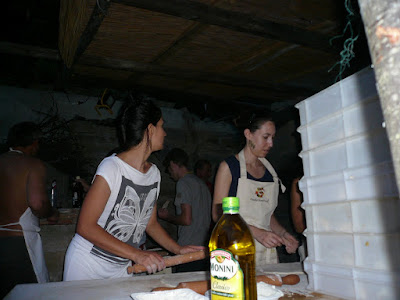The nostaglia first hit me in early July, while Paul and I were camping with our new friends. While at a Slow Food cooking class sponsored by the Mercato della Terra here in Bologna, I met Simone, a dynamic leader of a Slow Food chapter in Faenza, which is about an hour east of Bologna, and his equally vibrant girlfriend Hande. We hit it off right away, as we are all about the same age and are passionate about making Slow Food relevant and more accessible to a younger crowd. Simone and Hande invited Paul and I to an event at “Pian di Stantino,” an agro-tourism (agriturismo) farm near Faenza. Called “PiandiStantinoStock,” the event had the flavor of a mini, tame Woodstock (minus the drugs and mud). The party started on a Saturday afternoon, and included dinner, a concert, camping, and a leisurely day of hanging out on the farm on Sunday.

Pian di Stantino is run by another young couple, Martino and Denise, who are friends of Simone and Hande. They are carrying on the family business begun by Martino’s father, not because they are obligated to, but because they are passionate about sharing the message of promoting a lifestyle that is more connected to the land. They live on the small farm, grow their own fruits and vegetables, raise goats and one big pig called Ciccia, or “Fatty,” and as a source of income they host guests for dinner and overnight stays.

Pian di Stantino isn’t a place you would find on accident; it is hidden in the hills outside of the city. Once we arrived, I felt completely removed from normal life, and for the first time in a long time, felt entirely relaxed.
Around 400 people came to the event, and many of them were in their 20s and 30s like us. Though there were many babies, young children, and older adults too. Upon arrival, we each paid 15 euro, and received a drinking-glass mason jar that was tied on a long necklace made of twine. The entrance fee covered everything: a dinner that featured organic produce, locally-made wine, the concert, camping, and even breakfast and a light lunch the next day for those that wanted to stay around. On Saturday afternoon the neighbors who raise sheep came by and did a demonstration to show the kids how the sheep are sheered and how the wool is dyed with natural materials such as pomegranates.



Here we are hanging out before dinner. Paul and I are in the lower left, to the right is a local winemaker and his daughter, and in the back are Simone (left) and Martino (right).

Dinner, served on plates made of tree trunks from the property, included pizzas cooked in the outdoor wood-burning oven.

Hande (middle below) and I (left) quickly jumped in on the pizza-making operation, and rolled enough pizzas to have sore palms the next day.


The above photo shows the pizza oven, and Denise is shown in action below on the left, followed by a photo of an organic crostata that she baked with homemade jam.


While making pizzas with the group, I was happily brought back to the days when I was working as a cook, and soaked up the familiar mix of camaraderie and friendly taunting in the kitchen that seems to transcend location, culture, and language. But in addition to the comforting sense of engagement that I found in cooking with friends for a crowd, the experience was new enough to seem a bit like a dream. Could I really be learning how to make authentic pizza in a wood burning oven in Italy in the middle of a forest? It was magical, and the feeling only continued as the night went on. Simone and Hande took us to a spot toward the edge of the forest where hundreds of fireflies lit up a marsh. The last time I saw a firefly was at my grandma’s house on a lake in Missouri when I was 10, and in the 22 years since then I had completely forgotten about them and found myself in awe. Simone, Hande, Paul, and I sat on bales of hay, drank wine, watched the miniature light show, and listened to the cicadas in between sets of the band which was playing nearby.
Here is a picture of one of the performances, which was a pair of dancers with torches.

The event wasn’t officially part of Slow Food, but it embodied the exact same philosophy, and I hope that through Slow Food we can work to give more people, especially youth, an experience like we had at Pian di Stantino. It is through casual, affordable, and experiential events like these, rather than fancy dinners, that we will reach and captivate the younger generation.



